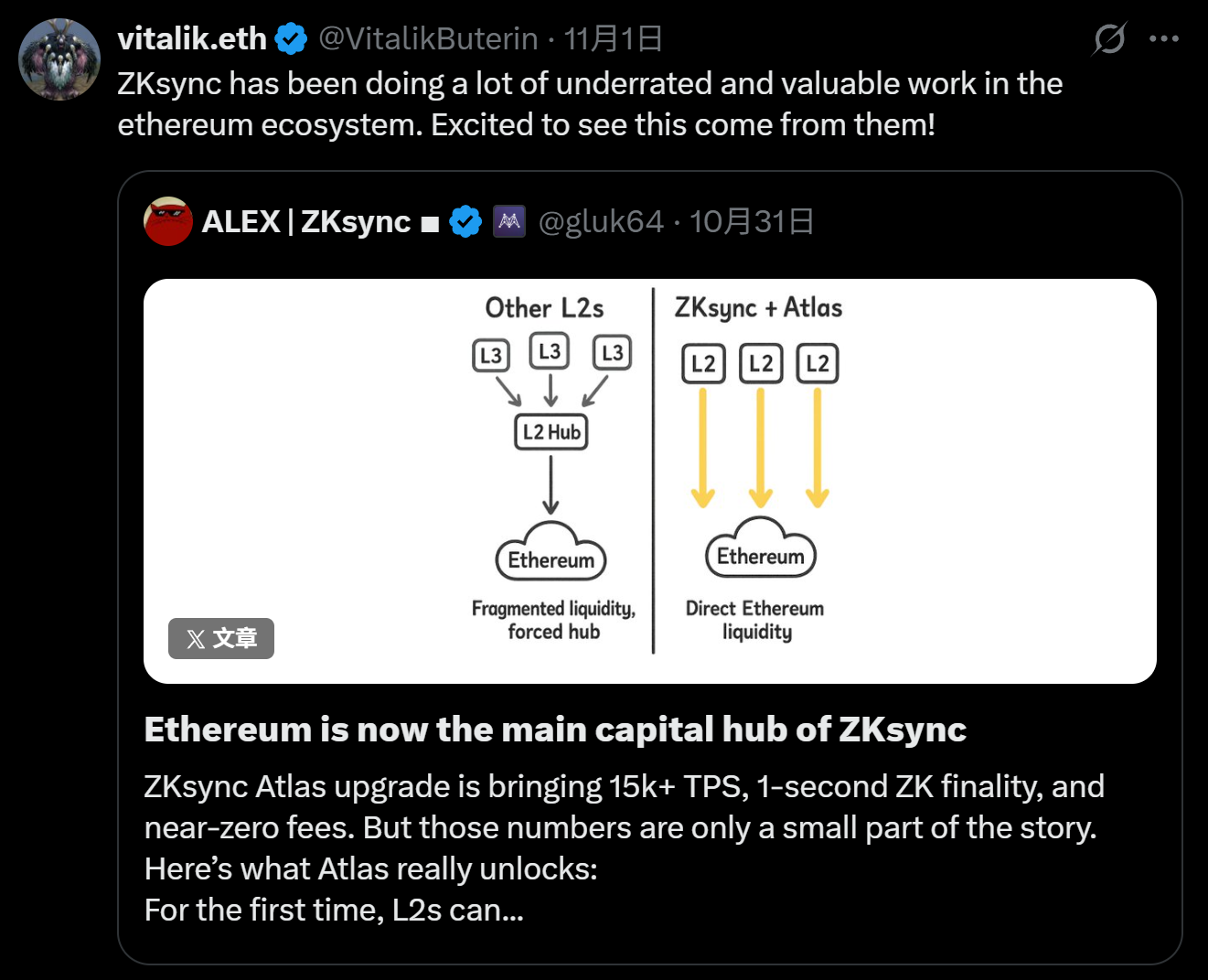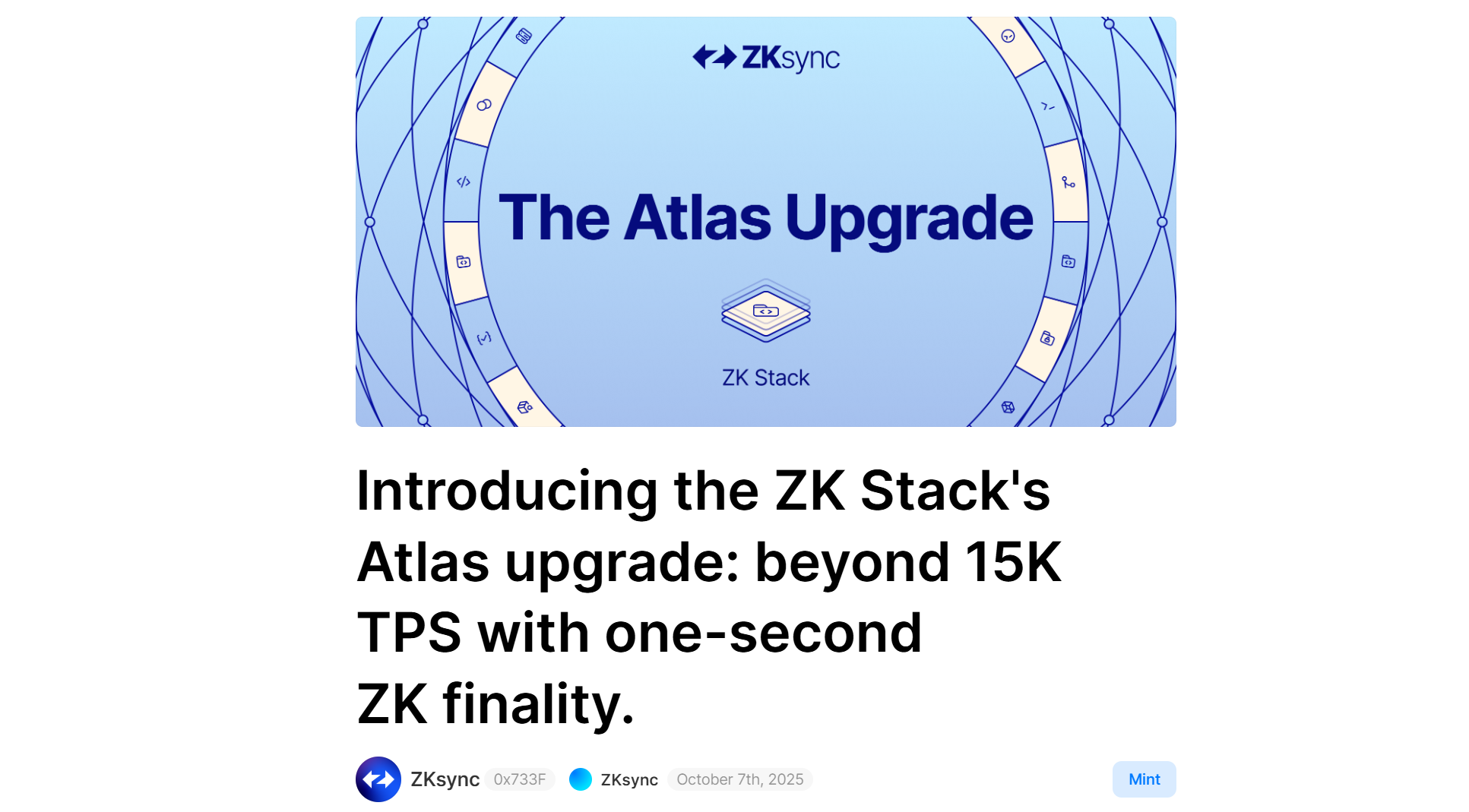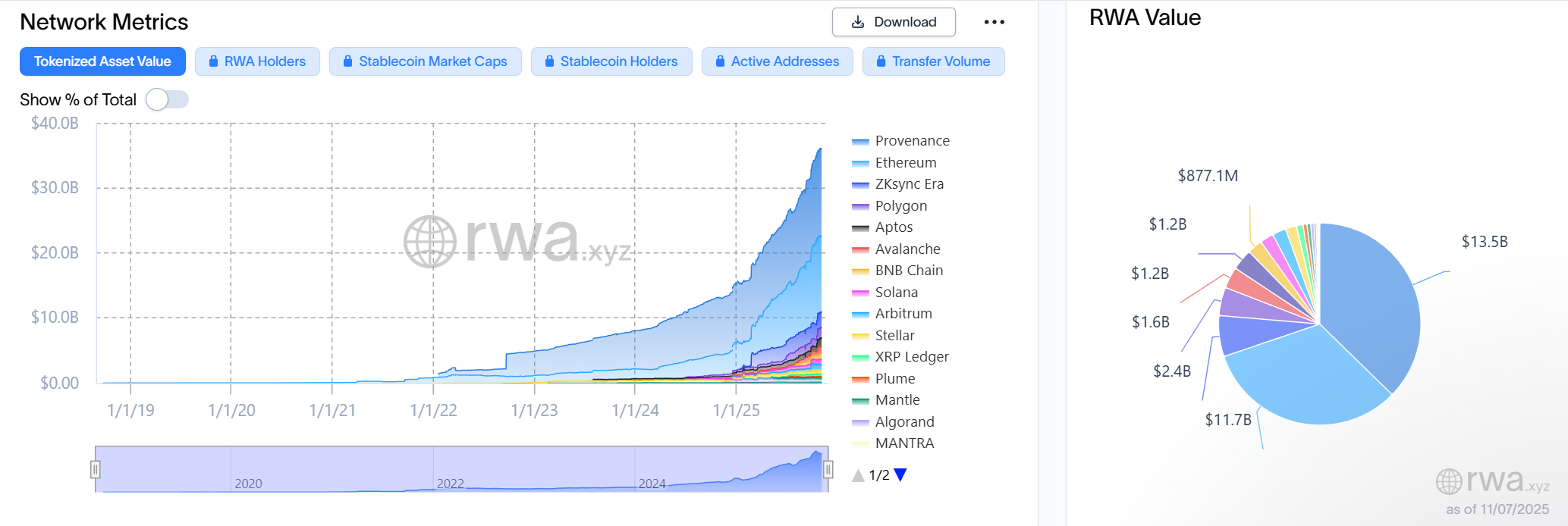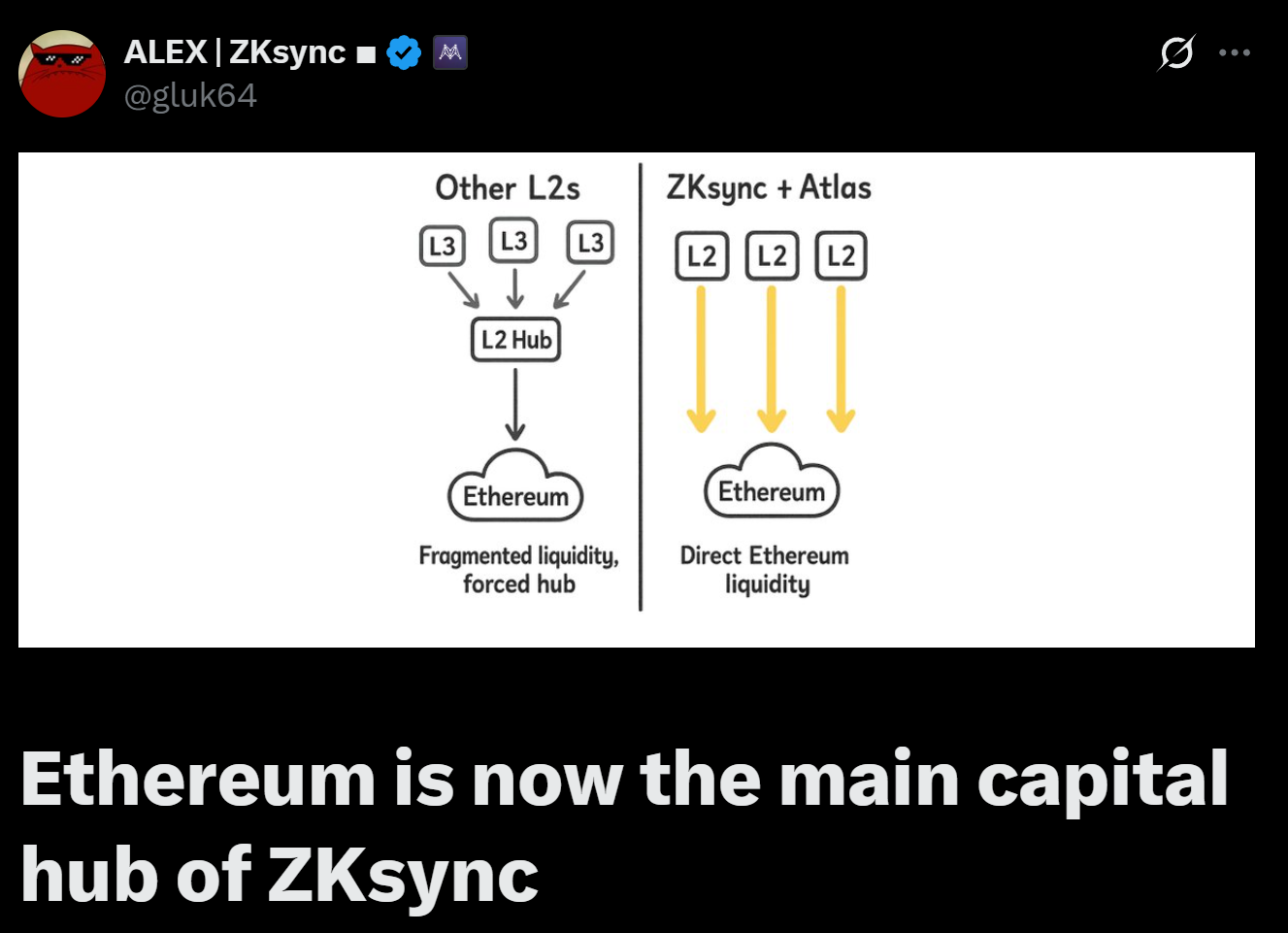Cold knowledge: Besides the Ethereum mainnet, what is currently the first chain for RWA?
The answer is — ZKsync.
That's right, this original L2, one of the "Four Kings" recently praised by Vitalik for "doing a lot of undervalued but very valuable work in the Ethereum ecosystem," is becoming the most representative project sample in Ethereum's ZK route.

Behind this, there are signals indicating that Ethereum is accelerating towards a "singularity moment" in the era of zero-knowledge proofs (ZKP): Ethereum's ZK route is transitioning from L2 expansion tools to the mainline logic that truly reshapes trust, performance, and ecological structure.
An Ethereum belonging to the "proof era" is gradually taking shape.
1. ZKsync, the new flagbearer of Ethereum ZKP
As an Ethereum scaling solution based on ZK Rollups developed by Matter Labs, ZKsync can be said to have been born with a golden spoon, being an early ZK Rollup scaling solution funded by the Ethereum Foundation.
It can be said that since 2019, it has almost grown alongside Ethereum's ZK technology route:
- In March 2019, it received funding from the Ethereum Foundation's fifth wave grant program to support its work on zero-knowledge proof L2 scaling;
- In September 2019: it secured $2 million in seed funding led by Placeholder VC;
- In March 2021: it completed a $50 million Series A funding round (led by Union Square Ventures);
However, due to the prolonged timeline, ZKsync has not been smooth sailing over the years.
First, during the unclear competitive landscape of Rollups from 2021 to 2023, OP L2 projects like Optimism and Arbitrum took the lead, while new public chains like Solana and Aptos also rose to prominence, causing ZKsync and other ZK routes to be marginalized by the market due to long iteration cycles.
It wasn't until the mainnet launch and airdrop last year that ZKsync re-entered the public eye, but the response was not all applause. Its airdrop distribution mechanism was controversial, the trust crisis caused by contract vulnerabilities had not yet subsided, and the developer Matter Labs was caught in a public relations whirlpool due to alleged intellectual property disputes.
Amidst this chorus of pessimism, ZKsync's progress on both the technical and ecological fronts remains noteworthy, as it continues to advance core underlying research and last month officially launched the upgraded version of ZK Stack — this is also a key step for ZKsync towards "enterprise-level on-chain."

Source: ZKsync
It integrates a high-performance sequencer capable of processing 25,000 to 30,000 transactions per second and supports sub-second confirmation with the Airbender proof system.
Notably, Airbender is currently the fastest single GPU verification speed zkVM; for example, on an RTX 4090, the average verification time is only 51 seconds, with costs as low as $0.01, setting a new industry record.
Another significant breakthrough for ZKsync is the Prividiums private chain architecture, which allows enterprises to interact with the Ethereum mainnet in a fully compatible manner while ensuring privacy, verifying transaction validity without exposing ledger information, achieving seamless interoperability between public and private systems.
This means that whether for on-chain securities, cross-border payments, or foreign exchange settlements, enterprises can achieve instant clearing and privacy protection within a compliant framework — this capability also makes ZKsync an ideal underlying layer for RWA (real-world assets) on-chain.
For this reason, ZKsync's performance in the RWA field is particularly outstanding. According to data from rwa.xyz, as of the time of writing, its on-chain tokenized asset issuance has exceeded $2.4 billion, second only to the Ethereum mainnet, making it the second-largest RWA issuance network in the entire ecosystem.
In other words, ZKsync is not only a testing ground for ZK technology but is also becoming the main ledger engine for real asset on-chain.

2. Is the endgame of zkEVM really here?
For a long time, zkEVM has been regarded as one of the "ultimate solutions" for scaling Ethereum, not only because it can solve performance bottlenecks but also because it redefines the trust mechanism of blockchain.
The core idea is to enable the Ethereum mainnet to generate and verify ZK proofs. In other words, after each block is executed, it can output a verifiable mathematical proof, allowing other nodes to confirm the correctness of the result without repeating the computation.
Specifically, the advantages of zkEVM focus on three aspects:
- Faster verification: Nodes do not need to replay transactions; they only need to verify zkProof to confirm block validity;
- Lighter burden: Effectively reduces the computational and storage pressure on full nodes, making it easier for light nodes and cross-chain validators to participate;
- Stronger security: Compared to OP routes, ZK's state proofs are confirmed in real-time on-chain, with higher tamper resistance and clearer security boundaries;
And now, all of this is accelerating towards reality.
Recently, the Ethereum Foundation (EF) officially released the L1 zkEVM real-time proof standard, marking the first formal inclusion of the ZK route into the mainnet-level technical planning. This standard is seen as a key starting point for the comprehensive introduction of zero-knowledge proof mechanisms — in the coming year, the Ethereum mainnet will gradually transition to an execution environment that supports zkEVM verification, achieving a structural shift from "re-execution" to "proof verification."
According to the technical roadmap published by EF, the block proof delay target is controlled within 10 seconds, the size of a single zk proof is less than 300 KB, and it adopts a 128-bit security level, avoiding trusted setups, and plans to allow household devices to participate in proof generation, lowering the decentralization threshold.
This means that the Ethereum mainnet is no longer just a settlement layer but is upgraded to a "verifiable world computer" with self-verification capabilities.
In this context, ZKsync is becoming one of the earliest practitioners; its founder Alex stated that with the completion of the Atlas upgrade, ZKsync has truly achieved verification integration with the Ethereum mainnet — the operating rhythm, confirmation speed, and liquidity of both are almost completely synchronized.

Currently, ZKsync's transaction final confirmation time is about 1 second, far faster than the Ethereum mainnet's 12-second block interval, meaning that trading on ZKsync is essentially consistent with the mainnet, only requiring waiting for mainnet confirmation. More critically, the cross-chain mechanism of ZK Rollup no longer has a challenge period of up to 7 days like Optimistic Rollup, resulting in a significant increase in transaction and fund flow speed.
In this structure, L2 is no longer a fragmented expansion branch but truly becomes a "parallel expansion network" of the Ethereum mainnet, where liquidity does not need to be repeatedly divided, and verification delays are significantly shortened. The long-standing issue of "L2 fragmentation" that has plagued the Ethereum ecosystem finally has a technical solution.
3. What kind of future is Ethereum moving towards?
If you have recently paid attention to Vitalik's activities on social media, you will notice a clear trend — he frequently retweets discussions related to Ethereum's scalability, especially topics about the evolution of zkEVM and L2 architecture.
In these mentions, besides ZKsync, there are also representative projects of the ZK ecosystem like Starknet, all pointing in the same direction: the ZK era of Ethereum is accelerating comprehensively.
Notably, barring any surprises, Ethereum's next network upgrade, Fusaka, is set to launch on the mainnet on December 3. It can be said that this version is one of the most influential network evolutions following The Merge and Dencun, with the core goal of making L2 cheaper, faster, and more open.
It brings higher data throughput to Rollup through the PeerDAS (Peer Data Availability Sampling) mechanism; at the same time, it introduces a new branch process called Blob-only parameter, restructuring network bandwidth, storage, and data writing methods, further optimizing mainnet resource utilization.
For Rollup developers, this means lower data writing costs and more flexible interaction space; for wallet and infrastructure providers, it means supporting more complex interactions and heavier node environments; for end users, it means lower experience costs and faster response times for on-chain operations; for enterprises and compliant users, EVM expansion and state proof simplification will also make on-chain interactions easier to integrate into regulatory systems and scale deployment.
So when zkEVM and Fusaka land together, the Rollup ecosystem is expected to usher in a true phase of scaling, and looking back over the past few years, Ethereum's roadmap has continuously evolved:
From the consensus upgrade of The Merge, to the data layering of Dencun, to the upcoming Fusaka and zkEVM, the entire mainline has always revolved around one core proposition: how to balance decentralization and scalability.
Now, this answer seems to be emerging in the mathematical light of ZK.
免责声明:本文章仅代表作者个人观点,不代表本平台的立场和观点。本文章仅供信息分享,不构成对任何人的任何投资建议。用户与作者之间的任何争议,与本平台无关。如网页中刊载的文章或图片涉及侵权,请提供相关的权利证明和身份证明发送邮件到support@aicoin.com,本平台相关工作人员将会进行核查。




